Who Killed Ruth Munson?
On Thursday, December 9, 1937, the badly burned body of Ruth Margaret Munson was found in the southwest corridor on the second floor of the Aberdeen Hotel in St. Paul. Munson and two friends were laughing and happy as they danced and listened to the orchestra for four hours at the Ace Box Bar, 2360 University Avenue, the previous evening. So what happened to Ruth between 12:30 a.m. when she left the bar, and 7:00 a.m. when her body was discovered? Sadly, investigators didn’t have many clues to work with, and the two girls Ruth was with the night she died were never positively identified and never came forward as witnesses, even after several pleas from police and family.
Originally from Grantsburg, WI, Ruth moved to St. Paul after her fiancée broke off their engagement because of the economic depression. Ruth worked a few domestic jobs before landing a position at the Union Depot Café. She was a popular waitress who loved working the early morning shift, arriving promptly at 6:15 a.m. to set her tables for the breakfast crowd. She would often walk to work from her rooming house at 276 Dayton Avenue. Her landlady, Mrs. Clara Broughton, remarked that she left the house at the same time every morning – like clockwork.
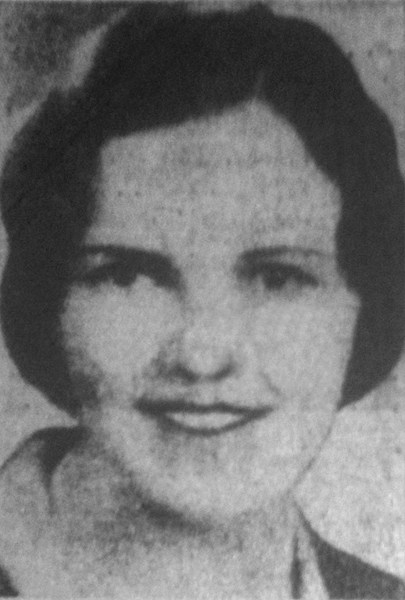
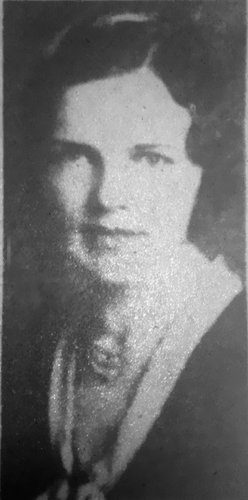
Ruth was a very pretty 30-year-old with chestnut brown hair who never lacked admirers. Mrs. Broughton noted that men would come to the door of the house wanting her to go out, but that she’d usually turn them down, and wasn’t the sort to hang out with shady characters. Ruth enjoyed going to bars around the Twin Cities with friends to watch the orchestras that were popular at the time, but was almost always home by 11:00 p.m. on weeknights. So when she didn’t arrive home on the night of December 8 and didn’t show for work the next morning, her landlady and friends at the Café became worried.
Around 6:55 a.m. on December 9, firefighters were called to the abandoned Aberdeen Hotel by neighbors who saw the glow of flames on the second floor of the normally dark building. It only took a few minutes to put out the fire, fire doors and plaster walls helped contain it to the second floor. Once the flames were out, fire crews started to clean up the water-soaked debris when the Captain came across what looked like parts of a human body. He called another firefighter over and together they confirmed it was the body of a female who had been badly beaten and burned. The woman’s skull had been fractured, and the forehead and upper end of the nose were caved in. She had been hit so hard with a blunt object that her skull was split open, bone exposed. The fire burned off both of her legs below the knees–firemen initially believed that they had been severed from the body, but after examining the body the coroner said they had been burned to ash. Ruth’s left arm to the elbow and fingers on her right hand were also burned off. Her face and torso were charred to the extent that she couldn’t be immediately identified. Beneath her naked body– which was laying on its back–were the remnants of a green dress, a corset, a small compact, four keys, two high heels, part of a purse, and bits of her imitation sealskin coat.
An empty can of naphtha was found in the corner opposite the body. Police arrived on the scene and quickly launched a room-by-room search of the entire hotel.
By 1:00 p.m. investigators tentatively identified the body as Ruth Munson after three people called to report her missing. Mrs. Broughton positively identified her by the set of four keys that were found with her body. She also disclosed that Ruth had received three phone calls after she left the house, two from women and one from a man. The coroner concluded from the condition of the non-burned skin on her back that Ruth had probably not been dead for more than two hours before the fire. The body, where the fire had not reached it, was not frozen in spite of the near zero degree temperatures in the building.
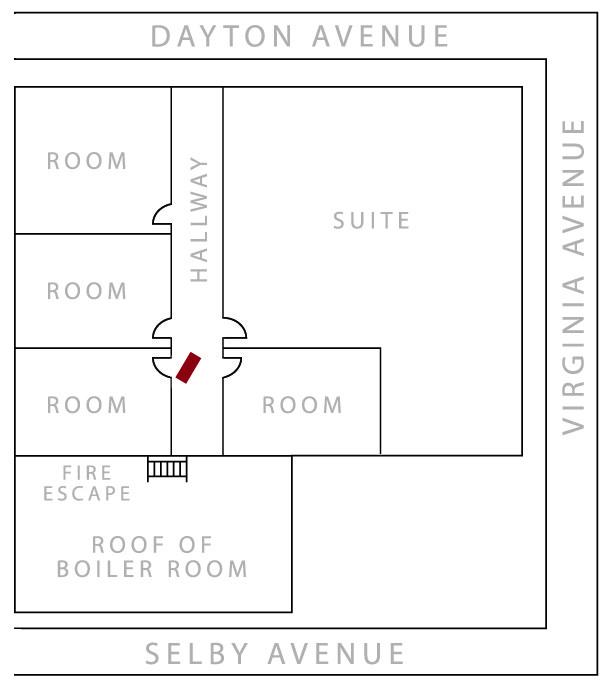
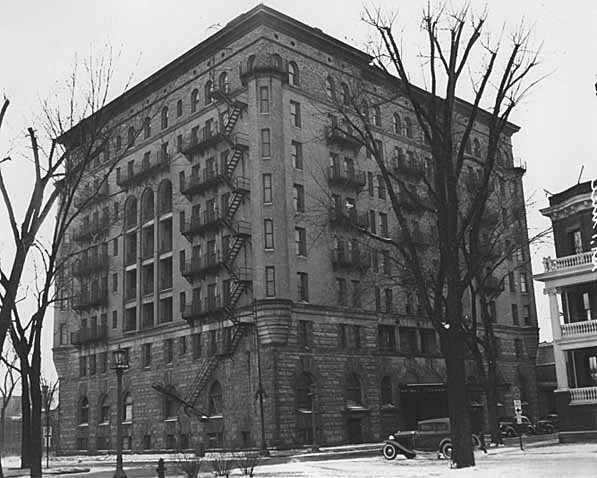
The residents of the district were jittery and eager for the murder to be solved. Over 100 friends and family were questioned and police went door-to-door seeking clues from neighbors. Investigators combed through Ruth’s apartment where they found a passage in her diary that simply stated, “the 9th day of the month is my lucky day.” Violet Thoreson, a waitress at Union Depot Café and close friend of Ruth’s, revealed that the week prior Ruth told her “I’ll never live to see Christmas.” Since she was killed on December 9th, investigators noted that perhaps Ruth knew something violent was going to happen to her.
Friends close to Ruth told police that she had been the object of an attempted attack four years prior. Then employed at Miller Hospital, she was walking to work at 6:00 a.m. when a motorist swung his car in her path near the Cathedral and attempted to pull her into his car. In the struggle, her wristwatch was broken and her lip was cut, but she got away. Her attacker was never caught.
Ruth’s landlady, Mrs. Broughton, stated that just before Ruth left the house the previous evening she’d received a call and was heard saying “yes, I would just as soon come stay with you.” It was believed that she was going to stay the night with a friend, Olive Nelson. When questioned, Mrs. Nelson said she had not seen Ruth in three days and hadn’t called or heard from her Wednesday night. It was later revealed that the caller was Mr. Derrick Das of Minneapolis, a widower with two children who asked Ruth to watch his children Thursday evening while he attended a meeting. When he asked her if she’d like him to bring the children to her apartment, she responded, “I would just as soon come over there.” The couple didn’t meet or have a further conversation.
Williard Wolfe, the owner of an auto garage next to the hotel, told the police about a man who walked up and wanted to make a cash-and-carry purchase of gasoline around 7:00 p.m. Wednesday night. He told the man that he didn’t sell gasoline and directed him to a filling station on University. As the man walked away, he turned east toward the Aberdeen Hotel, not west toward the filling station Wolfe had directed him to. Workers at the filling station reported they had not sold any gasoline in containers to customers Wednesday night or Thursday morning.
A Pioneer Press newspaper carrier reported that the Virginia Avenue gate to the Aberdeen Hotel was wired shut as usual when he went by at 4:55 a.m., but when he returned at 6:00 a.m. it was open. This corroborated another report from a neighbor who revealed that she had noticed that the gate was open when she walked to work at 5:30 a.m. Thursday morning. Examination revealed that the wire had been cut or broken.
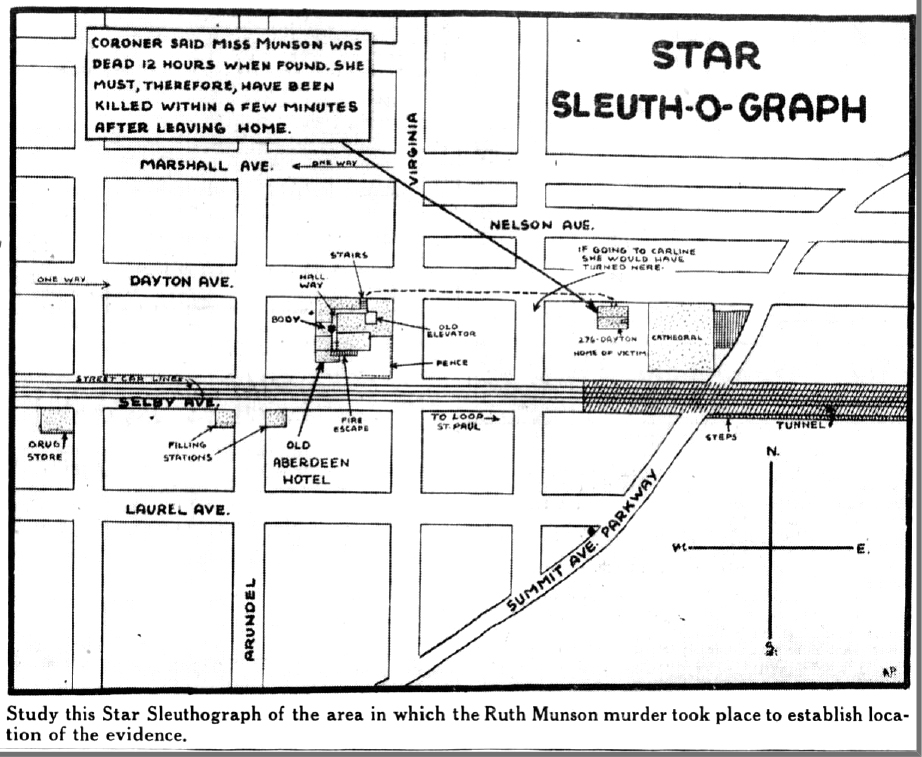
Mrs. Walter Martin, 452 Dayton Avenue, reported hearing two screams between 1:00 and 2:00 a.m. Thursday morning while she was sitting up reading. The first one was “an agonized, suffering yell, very loud.” The second was “much weaker.” She turned out her reading light and walked onto the porch but saw nothing. She also claimed to have seen a light on at the second floor of the Aberdeen about 6:00 p.m. Wednesday evening while on her way to the grocery store. Oscar Loberg of Dayton Avenue was awakened by what he called “an unholy scream” around 2:00 a.m., and another neighbor reported hearing a scream outside of her apartment building “around 2:30 a.m.,” neither investigated the source of the noise.
The coroner told police that Ruth had been sexually assaulted before her death, which spurred them to question perverts and degenerates in the area. It was their opinion that she was attacked on the street nearby, possibly knocking her unconscious, and then carried into the hotel through the basement door facing Selby Avenue, since it was found open. There was a clear path between the basement door and the corridor on the second floor where she was probably assaulted, murdered, and then burned. A fire door at the head of the stairs was burned, but the lock tumblers indicate that it had been unlocked – the only fire door found unlocked in the entire building.
All of these clues were helpful to the investigation but didn’t give police much in the way of a suspect. The only people who may have had a clue as to where Ruth went after she left the Ace Box Café were the two young women she had been with at the bar Wednesday night. Two bartenders remembered seeing the three women enter the bar together around 8:30 p.m. and leave around 12:30 a.m. without escorts. “They had a glass or two of 3.2 beer at the bar” and then sat down at a table at the edge of the dance floor. They occasionally danced with each other throughout the night but didn’t mingle with men. The bartenders also told police that the three women frequented the bar and were interested in the orchestra, they were friends with one of the members, known only as Ole. The staff at the bar didn’t know the identities of the women Ruth was with that night but reported that one was a brunette and the other had reddish-blonde hair. A waitress at the bar described the women as being “attractively, but not expensively dressed.” Police and family appealed to the two women to share what they knew, but neither of them ever came forward. Perhaps they were embarrassed to have been at the bar that night or were afraid to talk to police.
Without any more leads, the investigation slowed as 1938 approached. Several suspects were brought in for questioning, but no one was ever arrested. Newspaper headlines faded away, but the question of what happened to Ruth Munson remained on the minds of many St. Paulites throughout the years. A young woman was struck down in the prime of her life, and to this day no one knows who could have committed such a horrific crime, or why.
Ruth Munson’s killer has never been found.
